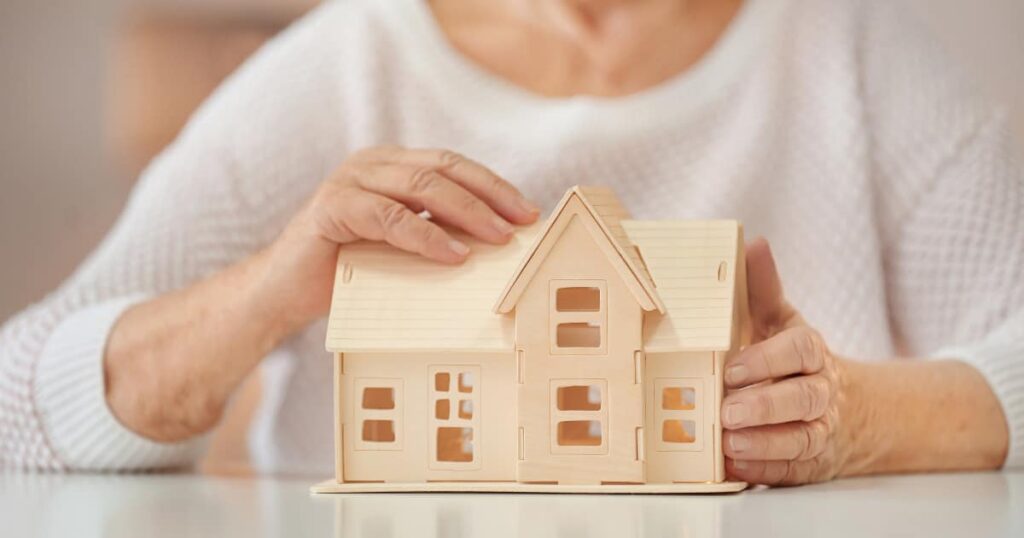**From 1 November 2025, the New Aged Care Act will introduce major changes to how residential aged care is delivered and managed. Please refer to the latest information in our Residential Aged Care Hub.
It is a common myth that older Australians must sell the family home to pay for aged care accommodation costs.
Let’s look at how residential aged care fees work, and the funding options that may be available for you.

How do fees and charges for residential aged care work?
There are three main fees that determine what you will pay for residential aged care in Australia:
Basic Daily Care Fee:
This covers the basic costs associated with living in a residential aged care facility, such as food and laundry. The Basic Daily Care Fee is the same for every resident, regardless of their income and assets, and is calculated at 77.86% of the standard full aged pension. This fee is paid periodically (usually fortnightly or monthly) and can be transferred directly from your pension.
Means-tested Care Fee:
This is an ongoing fee that covers the cost of personal and clinical care within an aged care residence. The Means-tested Care Fee is calculated based on income and assets, including your annual income, assets, marital status, superannuation, whether you own your home, and who is living in your home.
Your Means-tested Care Fee will be determined by an assessment coordinated by Centrelink or the Department of Veteran Affairs.
Accommodation Payment (RAD or DAP)
The cost of ‘buying’ or ‘renting’ a room in a residential aged care facility can be paid via a Refundable Accommodation Deposit (RAD), a Daily Accommodation Payment (DAP), or a combination of the two.
Whether you need to pay a RAD or DAP is dependent on your assets and income, and the amount payable will vary according to the cost of the room you choose.
Refundable Accommodation Deposit (RAD)
Paying a Refundable Accommodation Deposit is like ‘buying’ your room up front, and, as the name suggests, the amount paid is returned to you when you leave the facility.
Read more about RAD: Rad in Aged Care | Rad Payment Aged Care | Aged Care Decisions
Daily Accommodation Payment (DAP)
You can choose to pay a Daily Accommodation Payment, which is like ‘renting’ your room without having to pay a deposit. However, unlike the RAD, this periodical payment is not refundable. A DAP is calculated using the RAD amount for your chosen room, multiplied by a government-set interest rate (the MPIR), then divided by 365 days.
Read more about MPIR and DAP: All about the Maximum Permissible Interest Rate (MPIR) (agedcaredecisions.com.au)
Extra Services Fee
Some residential aged care facilities may charge extra fees for items such as pay TV or additional services. These fees are not government subsidised, so you must pay them in full if they apply. They are usually negotiable with Facility Management.
How much are the fees and charges for residential aged care?
Fees and charges for residential and home care are updated quarterly, and the most recent schedule can be found here: Schedule of Fees and Charges for Residential and Home Care (agedcaredecisions.com.au)
Aged Care Decisions’ FREE service for families can help you find residential aged care vacancies that suit your budget, location, care needs and personal preferences.
Connect with us here – our professionally-trained Placement Specialists are ready to assist.
Here’s how Aged Care Decisions’ FREE service works:
What are my options if I own my home?
If you own your home, it will be considered an asset if it is valued at more than $210,555.20.
Owning this asset can then impact the fees and charges you may pay for permanent residential aged care.
Should I sell my home to pay for aged care?
Selling your home is a big deal. We strongly recommend seeking advice from a finance expert with specific knowledge and experience in planning for aged care.
You need a plan that considers how you will fund the cost of your aged care accommodation and how you will pay ongoing care costs. You also need to consider any cashflow, pension, tax, and estate planning implications.
Some points you might discuss with a professional financial advisor are:
Who is living in your home?
If your spouse plans to remain living in the home, they may qualify as a ‘protected person’. A family home is not counted as an asset while a protected person lives there.
How does owning your home affect your pension?
Your home is exempt from the pension assets test for two years after you move into residential aged care. If you are part of a couple, the two years starts when the last spouse leaves the home.
Here is more information about the aged pension assets test: Assets test for pensions – Age Pension – Services Australia
How will selling your home affect your assets and income assessment?
If you sell your home, and the proceeds are significantly more than the cost of your RAD, then the lump sum of money leftover is likely to impact your assets and income test, your eligibility for the aged pension, and your means-tested care fees.
Is a reverse mortgage a good option for you?
A reverse mortgage is a loan that allows you to access the equity in your home without selling it. Instead of making monthly payments to a lender, as with a traditional mortgage, the lender makes regular payments to the borrower.
What is your maximum budget for residential aged care?
The average RAD in Australia currently sits at around $470,000 but they can go much higher, depending on location, features, and inclusions. If you are not eligible for a fully subsidised room, you will need to have a maximum budget in mind before you start looking for residential aged care vacancies.
How will you find a residential aged care facility that suits you?
This is where Aged Care Decisions can help. At Aged Care Decisions we match thousands of Australian seniors with suitable residential aged care vacancies.
Connect with us now to receive a FREE, tailored, interactive Options Report, shortlisting relevant, current residential aged care vacancies for you to review, consider and compare.







